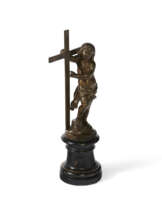CERCLE DE FERDINANDO TACCA (1619-1686), D`APRÈS GIAMBOLOGNA, XVIIE SIÈCLE
11.12.2025 00:00UTC +00:00
Classic
To bid, go to the website
CHRISTIE'S| Auctioneer | CHRISTIE'S |
|---|---|
| Event location | United Kingdom, London |
| Buyer Premium | see on Website% |
ID 1514295
Lot 24 | CERCLE DE FERDINANDO TACCA (1619-1686), D'APRÈS GIAMBOLOGNA, XVIIE SIÈCLE
Estimate value
70000EUR € 70 000 – 100 000
Probablement L'Enlèvement de Cybèle par Saturne ou L'Enlèvement de Proserpine par Pluton
bronze, sur une base postérieure en marbre vert
H. 60 cm. (23 5/8 in.), H. totale 74,5 cm. (29 ¼ in.)
Provenance
Edgard-Salomon Stern (1854-1937) et Marguerite Stern née Fould (1866-1956), château de Villette, Pont-Sainte-Maxence, Oise (selon les archives RG 260 M1943 Reel 26 NARA; Bundesarchiv, B323/289; RA 8, RV 103, MAEE, Paris, France) ;
D'où confisqué par le Einsatzstab Reichsleiter Rosenberg suite à l'occupation allemande de la France (ERR inv. ST62, comme par Pietro Francavilla) ;
Transféré au Louvre, Paris, le 13 décembre 1940 ;
Transféré au Jeu de Paume, Paris ;
Transféré aux mines de sel d'Altaussee, Autriche ;
Transféré au Central Collecting Point, Munich, le 18 juin 1945 (MCCP inv. 139/1) ;
Retourné en France, le 31 juillet 1946, puis restitué à Marguerite Stern, le 4 octobre 1946 ;
Puis par descendance à leur fils, Maurice Stern (1888-1962) et leur belle-fille Alice Stern née Goldschmidt (1906-2008), 5 Avenue George V, Paris ;
Puis par descendance.
Literature
Bibliographie comparative :
L. Planiscig, Collezione Camillo Castiglioni : Catalogo dei bronzi con introduzione e note descrittive di Leo Planiscig, Vienne, 1923, pp. 9-13, p. 46 et lot 90.
C. Avery et A. Radcliffe, Giambologna (1529-1608), sculptor to the Medici, cat. exp. Londres, Édimburg et Vienne, 1978, pp. 105-107, cat. 56-57.
Further details
A BRONZE GROUP PROBABLY REPRESENTING SATURN AND CYBELE OR PLUTO AND PROSERPINA, CIRCLE OF FERDINANDO TACCA (1619-1686), 17TH CENTURY
An interesting and rare composition, our group appears to be the only known example alongside the one formerly in the collection of the Italo-Austrian financier and aviation pioneer Camillo Castiglioni (1879–1957).
A few subtle differences in execution - notably in the hair of the male figure and the foliage held in the hands of the female figure - demonstrate that they are indeed distinct (see illustration in the Camillo Castiglioni sale catalogue, Amsterdam, A. Mensing auction house, 18 November 1925, lot 90).
The model of this abduction clearly belongs to the tradition of Giambologna and his Rape of a Sabine with two figures (C. Avery and A. Radcliffe, pp. 105–107, cat. 56–57), a model conceived around 1579 for Octave Farnese (see the bronze at the Museo e Galleria Nazionale di Capodimonte, Naples, inv. 10524). This subject became popular from the late 16th century, allowing the sculptor to demonstrate their skill by creating multiple viewpoints. However, unlike Giambologna, our group intensifies the upward motion of the composition by raising the female figure higher and nearly separating the two bodies from one another.
Leo Planiscig, in his commentary for the Castiglioni sale, noted that this bronze was previously unpublished and attributed it to Pierre de Francqueville, known as Pietro Francavilla (1548–1615). Born in Cambrai, Francavilla worked extensively in Italy and was a pupil of Giambologna. Summoned to Paris by Henri IV, he gave up his role as Giambologna’s principal assistant to Pietro Tacca and returned to France. He is known to have created a group representing The Abduction of Cybele by Saturn, which once adorned the gardens of the Tuileries, and was reportedly later transferred to the Château de Pontchartrain. In the absence of further documentation, it is more prudent today to associate this group with the circle of Ferdinando Tacca (1619–1686), Pietro’s son, particularly based on stylistic comparisons in the treatment of the figures, faces, and movement.
The iconography of the group remains open to interpretation. As Planiscig suggested, the scene could represent Saturn abducting Cybele - Cybele being associated with nature and fertility, as indicated by the branches she holds. However, the figures could also depict Pluto and Proserpina: the daughter of Ceres, Proserpina is likewise linked to nature and the seasonal cycle.
This bronze was part of the decoration of the Château de Villette in Pont-Sainte-Maxence. Construction was begun in 1900 by Edgard-Salomon Stern in a Louis XIII Revival style on the site of a former château dating from the reign of Louis XV. The estate became a prominent venue during the Belle Époque. Seized during the Second World War, the bronze was transferred from the château to the Jeu de Paume on 13 December 1940, and later sent to the salt mines of Altaussee, in Austria. It was then moved to the Central Collecting Point in Munich on 18 June 1945, repatriated to France on 31 July 1946, and finally returned to the Stern family on 4 October 1946.
| Artist: | Ferdinando Tacca (1619 - 1686) |
|---|---|
| Applied technique: | Metalwork |
| Medium: | Bronze |
| Genre: | Mythological painting |
| Place of origin: | Italy, Europe |
| Auction house category: | All other types of objects, Sculptures, Statues & Figures, Statuettes |
| Artist: | Ferdinando Tacca (1619 - 1686) |
|---|---|
| Applied technique: | Metalwork |
| Medium: | Bronze |
| Genre: | Mythological painting |
| Place of origin: | Italy, Europe |
| Auction house category: | All other types of objects, Sculptures, Statues & Figures, Statuettes |
| Address of auction |
CHRISTIE'S 8 King Street, St. James's SW1Y 6QT London United Kingdom | |
|---|---|---|
| Preview |
| |
| Phone | +44 (0)20 7839 9060 | |
| Buyer Premium | see on Website | |
| Conditions of purchase | Conditions of purchase |










